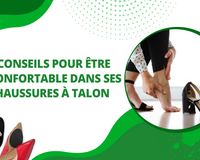Rheumatoid arthritis is an inflammatory disease that affects the joints of the entire body. This chronic disease causes pain in the hands and feet in over 90% of cases.
Generally genetic in origin, this pathology is a frequent cause of disability. When the ankle and foot are affected, we speak of foot rheumatism. Unlike osteoarthritis of the foot, which manifests itself as mechanical joint pain, rheumatoid arthritis of the foot can lead to foot deformities such as Achilles tendon, hammertoes or even Hallus valgus.
Let's find out more about this joint disease and how to relieve the pain it causes.
DESCRIPTION OF FOOT ARTHRITIS
Arthritis of the foot is an inflammation of the genetic that can cause joint pain. There are two types of arthritis: osteoarthritis and rheumatoid arthritis.
What is arthritis of the foot?
Also known as bone and joint disease, arthritis of the foot is a joint disease that can lead to the destruction of joints and the ligaments that support them. support.
The result is joint inflammation and foot pain due to deformity. Inflammation here is synonymous with stiffness, pain, swelling or redness of the foot.
How is arthritis of the foot produced?
Arthritis of the foot is considered to be a autoimmune disease disease that can present pain right from the start. This is because the body's defence and protection system against infections attacks its own tissues in reverse.
In rheumatoid arthritis, the body's own protective defenses soften the bones and mistakenly damage healthy tissue. The result is reduced range of motion, inflammatory rheumatism and painful foot bones.
Some statistics on arthritis of the foot
Rheumatoid arthritis is a joint disease predominantly affecting women. Of 3 patients showing signs of rheumatoid factor, 2 are women and 1 is a man. Politic arteritis rheumatoidum, also known as tendon and ligament disease, generally presents more symptoms in people aged between 40 and 60.
CAUSES RHEUMATOID ARTHRITIS

When asked what triggers rheumatoid arthritis, several ideas have been put forward. Doctors consider rheumatoid arthritis to be a "disease of the body". genetic disease whose cause is not known with certainty.
From a genetic point of view, due to the genes genes Some people are even more likely to develop the disease than others. Despite the presence of disease genes in the body, the presence of triggers is essential to cause the disease.
According to a number of studies, hormonal, psychological, environmental and even infectious factors may favor the onset of the disease. rheumatoid arthritis.
RHEUMATOID ARTHRITIS FOOT SYMPTOMS
Inflammatory arthritis refers to all forms of arthritis except osteoarthritis. Apart from rheumatoid arthritisarthritis psoriatic arthritis and polyarthritis ankylosing arthritis are also widespread forms of inflammatory arthritis.
In addition to these, there are other little-known forms of inflammatory arthritis. There are also systematic forms that attack joints throughout the body.
For example, arthritis in the hand or pain in the finger joint can be felt by the sufferer. From rheumatoid arthritis of the knee to arthritis of the hand or even arthritis of the finger, rheumatoid arthritis can be detected through a number of symptoms. signs.
Signs of rheumatoid arthritis
Joint swelling and stiffness, accompanied by joint pain in the fingers or feet, are signs of rheumatoid arthritis. manifestations of rheumatoid arthritis. However, symptoms are most often felt in the morning on waking and at the end of the night.
This is why people suffering from inflammatory polyarthritis foot pain tend to have trouble bending their fingers when they wake up. They may also experience pain joint pain at night.
Unlike osteoarthritis, which tends to affect a specific joint, rheumatoid arthritis affects mostly the same joints in both feet. The more this pathology progresses, the more the foot adopts a high sedimentation rate and fatigues the joints.
This will lead to deformation of the ankles and feet over time. As soon as a polyarthritic symptom is observed, it's vital to carry out an ultrasound examination. X-ray rheumatology of the foot.
Rheumatoid arthritis of the hindfoot
The back of the foot usually provides support for lateral movements when walking. Pain under the fibula outside ankle arthritis is a consequence of signals such as difficulty walking on gravel or uneven ground.
The more the disease progresses, the more the initial posture of the foot is deviated. A flatfoot or hallux valgus deformity may be the result of bones moving out of their normal position.
As a result, the foot may present painful articulations more specifically on the outside or inside of the ankle, or even posterior tibial tendon.
Rheumatoid arthritis in the midfoot
When a person suffers from rheumatoid arthritisthe arch of the foot will tend to collapse, due to the weakening of the ligaments supporting the midfoot. The collapse of the arch creates an imbalance in footing. As time goes by, the structures of the foot degenerate and its initial shape changes.
One or more painful bumps may appear at the level of the arch making it difficult to wear shoes painful. Cartilage is also damaged by rheumatoid arthritis and can lead to the formation of a flat foot, as with arthritic hindfoot.
Rheumatoid arthritis in the forefoot

Most people with toe arthritis suffer from pain in the joints at the front of the foot. Generally constant, forefoot artritis leads to deformities such as metatarsalgiaclaw toes and hallux valgus.
The majority of patients experience all these deformities, which weaken the entire metatarsophalangeal joint. Hallux valgus is generally observed, and one big toe may even pass over the other.
As a result, calluses or corns form on the soles of the feet and toes, making heating extremely difficult. Although these areas are the most painful in patients with toe joint pain, knee arthritis is also seen in some people. The image above is a photo of arthritis of the foot.
HOW IS RHEUMATOID ARTHRITIS TREATED?
Generally associated with other autoimmune diseases, rheumatoid polyarthritis of the feet is a condition with no specific cure. Despite this, there are treatments rheumatoid arthritis foot pain.
- Multidisciplinary treatment of rheumatoid arthritis is recommended.
- Medication-assisted management by a specialist rheumatologist, physiotherapist, modo-prosthetist, occupational therapist or even a rehabilitation physician can relieve painful tendons throughout the foot.
- Orthopedic treatment starting with the wearing of adapted footwear impregnated with orthopedic inserts is also an effective alternative for treating foot pain.
Diagnosis of rheumatoid arthritis
Before considering treating any disease, it is advisable to carry out an examination or diagnosis of the symptoms it presents. In addition to observing symptoms, the biological diagnosis of rheumatoid arthritis is based on blood tests and medical imaging examinations such as ultrasound and X-rays.
Rheumatoid arthritis foot non-surgical treatment
From the very start of rheumatoid arthritis of the foot, wearing footwear for osteoarthritis of the foot and custom-fitted orthoses can help to relieve pain. Although the latter can provide relief, they do not stop the evolution and progression of the disease.
In this case, the treatment orthopedic treatment appears as a complement to modifying antirheumatic drugs, which are specific medicines manufactured to prevent the destruction of joints by the immune system. It is important to follow a rheumatologist's instructions to the letter, in order to make the best use of these drugs.
Surgical treatment is deployed when the pathology is already at a severe stage, or if non-surgical treatments have not worked.
Surgical treatment of rheumatoid arthritis foot
The surgery aims to give the patient a normal life by making the foot non-conflicting and painless to wear. Surgical treatment of rheumatoid arthritis of the feet is recommended by a foot specialist when the disease is already at a stage advanced and is accompanied by deformities.
- Arthroplasty is the dedicated operation to remedy this condition. Depending on the case, the surgeon may proceed with either joint preservation to correct hammertoes and hallux valgus in patients.
- The joint replacement is also a type of foot arthritis surgery aimed at repairing or replacing a damaged joint with a new one in normal condition.
- In addition joint fusion is a rheumatoid nodule surgery procedure and represents the most common type of rheumatoid arthritis surgery.
Fusion surgery involves fusing two bones that form a joint into a single joint. The forefoot is the area where there are several surgical options in the majority of patients.
Depending on your case, your surgeon will be able to examine the most appropriate procedures for you.
How to relieve an arthritic foot?

Although many people wonder how long an arthritis attack lasts, its duration varies according to a number of factors. It can last from a few days to several weeks. weeks.
People suffering from arthritis of the big toe may often experience an arthritis attack in the foot. If this happens, it is advisable to rest the affected part of the foot. Arthritis of the big toe becomes extremely painful during an attack.
Techniques for physiotherapys such as gentle massage can help relieve pain and maintain foot mobility. Applying a warm towel or taking a hot bath can help soothe aching joints.
FAQ
Rheumatoid arthritis life expectancy
Although rheumatoid arthritis does not kill immediately, it can reduce life expectancy from 3 to 10 years.
This disease can lead to complications if accompanied by factors such as obesity, smoking or even periodontal disease.
Can you die from rheumatoid arthritis?
Rheumatoid arthritis is a chronic, even serious disease that can lead to death if not treated as early as possible.
How long can you live with rheumatoid arthritis?
According to the opinion of rheumatology specialists life expectancy of a person suffering from polyarthritis depends on several factors: medical follow-up, the patient's age (the disease is more fragile in the elderly than in young people), the severity of symptoms and even comorbidities.









